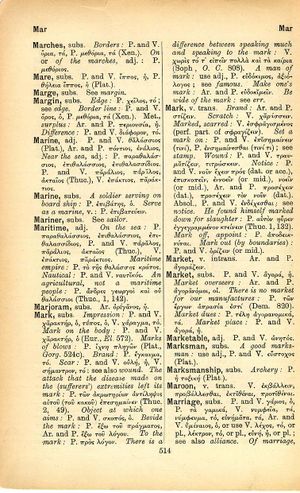mark: Difference between revisions
μοχθεῖν τε βροτοῖσ(ιν) άνάγκη → and you mortals must endure trouble (Euripides' Hippolytus 208)
(Woodhouse 3) |
(CSV4) |
||
| Line 1: | Line 1: | ||
{{ | {{Woodhouse1 | ||
| | |Text=[[File:woodhouse_514.jpg|thumb|link={{filepath:woodhouse_514.jpg}}]]'''subs.''' | ||
<b class="b2">Impression</b>: P. and V. [[χαρακτήρ]], ὁ, [[τύπος]], ὁ, V. [[χάραγμα]], τό. | |||
<b class="b2">Mark on the body</b>: P. and V. [[χαρακτήρ]], ὁ (Eur., ''El.'' 572). | |||
<b class="b2">Marks of blows</b>: P. ἴχνη πληγῶν (Plat., ''Gorg.'' 524C). | |||
<b class="b2">Brand</b>: P. [[ἔγκαυμα]], τό. | |||
<b class="b2">Scar</b>: P. and V. [[οὐλή]], ἡ, V. [[σήμαντρον]], τό:see also [[wound]]. | |||
<b class="b2">The attack that the disease made on the</b> (<b class="b2">sufferers</b>) <b class="b2">extremities left its mark</b>: P. τῶν ἀκρωτηρίων [[ἀντίληψις]] [[αὐτοῦ]] (τοῦ κακοῦ) ἐπεσημαίνεν (Thuc. 2, 49). | |||
<b class="b2">Object at which one aims</b>: P. and V. [[σκοπός]], ὁ. | |||
<b class="b2">Beside the mark</b>: P. [[ἔξω]] τοῦ πράγματος, Ar. and P. [[ἔξω]] τοῦ λόγου. | |||
<b class="b2">To the mark</b>: P. πρὸς λόγον. | |||
<b class="b2">There is a difference between speaking much and speaking to the mark</b>: V. χωρὶς τό τʼ εἰπεῖν πολλὰ καὶ τὰ καίρια (Soph., ''O.C.'' 808). | |||
<b class="b2">A man of mark</b>: use adj., P. [[εὐδόκιμος]], [[ἀξιόλογος]]; see [[famous]]. | |||
<b class="b2">Make one's mark</b>: Ar. and P. εὐδοκιμεῖν. | |||
<b class="b2">Be wide of the mark</b>: see [[err]]. | |||
'''v. trans.''' | |||
<b class="b2">Brand</b>: Ar. and P. στίζειν. | |||
<b class="b2">Scratch</b>: V. χαράσσειν. | |||
<b class="b2">Marked, scarred</b>: V. ἐσφραγισμένος (perf. part. of σφραγίζειν). | |||
<b class="b2">Set a mark on</b>: P. and V. ἐπισημαίνειν (τινί), P. ἐνσημαίνεσθαι (τινί τι); see [[stamp]]. | |||
<b class="b2">Wound</b>: P. and V. τραυματίζειν, τιτρώσκειν. | |||
<b class="b2">Notice</b>: P. and V. νοῦν ἔχειν [[πρός]] (dat. or acc.), ἐπισκοπεῖν, ἐννοεῖν (or mid.), νοεῖν (or mid.), Ar. and P. προσέχειν (dat.), προσέχειν τὸν νοῦν (dat.). Absol.. P. and V. ἐνδέχεσθαι; see [[notice]]. | |||
<b class="b2">He found himself marked down for slaughter</b>: P. αὑτὸν ηὗρεν ἐγγεγραμμένον κτείνειν (Thuc. 1, 132). | |||
<b class="b2">Mark off, appoint</b>: P. ἀποδεικνύναι. | |||
<b class="b2">Mark out</b> (<b class="b2">by boundaries</b>): P. and V. ὁρίζειν (or mid.). | |||
}} | }} | ||
Revision as of 09:46, 21 July 2017
English > Greek (Woodhouse)
subs.
Impression: P. and V. χαρακτήρ, ὁ, τύπος, ὁ, V. χάραγμα, τό. Mark on the body: P. and V. χαρακτήρ, ὁ (Eur., El. 572). Marks of blows: P. ἴχνη πληγῶν (Plat., Gorg. 524C). Brand: P. ἔγκαυμα, τό. Scar: P. and V. οὐλή, ἡ, V. σήμαντρον, τό:see also wound. The attack that the disease made on the (sufferers) extremities left its mark: P. τῶν ἀκρωτηρίων ἀντίληψις αὐτοῦ (τοῦ κακοῦ) ἐπεσημαίνεν (Thuc. 2, 49). Object at which one aims: P. and V. σκοπός, ὁ. Beside the mark: P. ἔξω τοῦ πράγματος, Ar. and P. ἔξω τοῦ λόγου. To the mark: P. πρὸς λόγον. There is a difference between speaking much and speaking to the mark: V. χωρὶς τό τʼ εἰπεῖν πολλὰ καὶ τὰ καίρια (Soph., O.C. 808). A man of mark: use adj., P. εὐδόκιμος, ἀξιόλογος; see famous. Make one's mark: Ar. and P. εὐδοκιμεῖν. Be wide of the mark: see err. v. trans. Brand: Ar. and P. στίζειν. Scratch: V. χαράσσειν. Marked, scarred: V. ἐσφραγισμένος (perf. part. of σφραγίζειν). Set a mark on: P. and V. ἐπισημαίνειν (τινί), P. ἐνσημαίνεσθαι (τινί τι); see stamp. Wound: P. and V. τραυματίζειν, τιτρώσκειν. Notice: P. and V. νοῦν ἔχειν πρός (dat. or acc.), ἐπισκοπεῖν, ἐννοεῖν (or mid.), νοεῖν (or mid.), Ar. and P. προσέχειν (dat.), προσέχειν τὸν νοῦν (dat.). Absol.. P. and V. ἐνδέχεσθαι; see notice. He found himself marked down for slaughter: P. αὑτὸν ηὗρεν ἐγγεγραμμένον κτείνειν (Thuc. 1, 132). Mark off, appoint: P. ἀποδεικνύναι. Mark out (by boundaries): P. and V. ὁρίζειν (or mid.).

